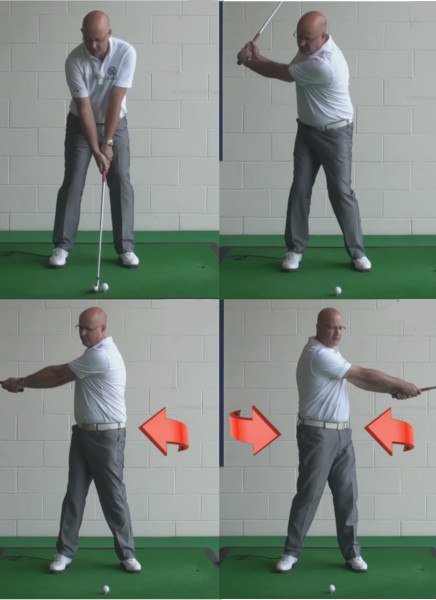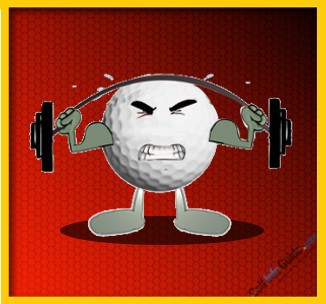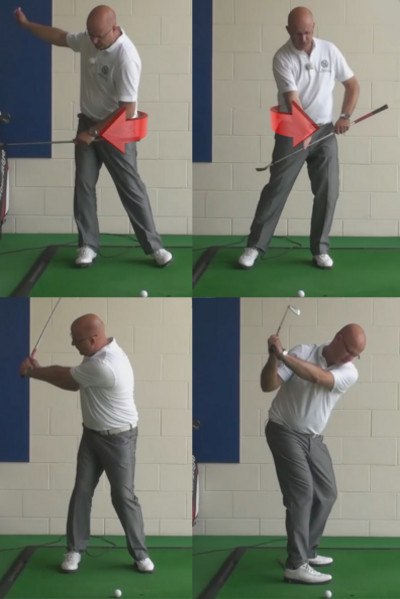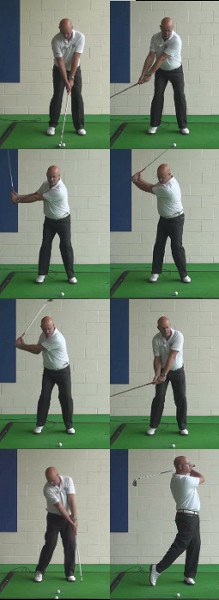
To create a golf swing that is repeatable and powerful, the big muscles need to be used. Find out how with this tip.
The 'muscles' of a golf swing are a way of referring to the different parts of the body rather than a particular muscle or muscle group so have no fear, a biology degree is not needed! The 'big' muscles of a golf swing are usually described as the back, shoulder and trunk areas and the 'little' muscles are a way of describing the hand, arm and wrist areas of the body.
The golfer needs to use the bigger muscles of the body to create a golf swing as the bigger muscles are; stronger and so can produce more power for greater distance; bigger and so produce bigger movements that are easier to control for accuracy; fewer and so a golf swing will be more consistent as there are less movements to repeat.
Imagine the golf swing as a circle or arc. The club head should swing around the outside of the circle in a consistent fashion. The bigger muscles (shoulders and hips) allow this to happen as they rotate around the spine which is the centre of the circle. If we imagine a wheel, the arms are the spokes of the wheel, staying still, keeping the club head the same distance away from the body throughout the swing on the same circle. Using the small muscles of the arms and hands means that the arms bend at the elbow pulling the circle closer in towards the body. More movement in the limbs means less likelihood of performing the same set of movements each time.
As an additional note, the further the golf club is away from the body, the faster it will travel creating a longer golf shot. If the arms bend at the elbow, the closer the club head is to the body and the slower it will travel losing distance instead.
Here is an exercise to get the bigger muscles to swing the golf club. Practice swinging like a baseball swing. Stand up straight rather than setting up with the golf club on the floor and swing the golf club horizontally around the body at approximately chest height. While doing this, keep the arms still and feel the hips and shoulders powering the movement. Slowly with each swing, bend forwards from the hips making sure that the shoulders do not curve forward, and lower down to the ball still feeling the 'bigger muscles' of the hips and shoulders swinging the club rather than the arms and hands. The swing should feel more rounded and the club should feel like it is being swung behind and around the body rather than over the head in the backswing.
Swing through the ball in this way and the swing will be more under control, providing more consistent golf shots.

How Big Muscles Help to Create a Flawless Swing?
Your hands are the only point of contact that you have with the golf club during the swing. With that fact in mind, it would be easy to think that you should swing the club mostly with your hands and other small muscles. In fact, this is the approach that many amateur golfers take to the game of golf. Unfortunately, it is completely wrong. You should be doing exactly the opposite if you would like to build a reliable, powerful golf swing. Learn how to tap into everything that your big muscles have to offer and your game will gradually improve.
When you watch professional golfers hit powerful drives hole after hole on TV, you can be sure that they are using their big muscles effectively. You certainly don't have to be a bodybuilder to play this game well, but you do need to know how to tap into all of the power that your body has available. By using your body in an efficient manner throughout the swing, you can transfer a great deal of energy from your rotation down into the club – and eventually, into the ball. There is more to playing good golf than just using your big muscles, but this is definitely a great place to start.
The great thing about learning how to use your big muscles in the golf swing is the fact that you can use them effectively in the short game as well. Playing short shots around the green can be difficult when you choose to use the small muscles in your hands and wrists. Even though the ball only needs to travel a short distance, it is still best to employ the use of your large muscle groups. Later in this article, we will offer some advice on how to use your big muscles properly on and around the greens.
If you are an experienced golfer, you already know how difficult this game can be. Rather than expecting immediate results when you start to use your big muscles, you should instead look for small signs of progress along the way. Golf is too hard to make one quick change and suddenly be a whole new player. You have to work on your technique over a period of time while paying attention to even the smallest of details. Golf is fun, to be sure, but nobody ever said it was easy. If you aren't willing to stick it out through the rough patches early on in this process, you will never get to enjoy the fruits of your labor down the road. Be patient with yourself, watch for little indications of progress, and enjoy the journey toward a better game.
All of the content below is based on a right-handed golfer. If you happen to play golf left-handed, please take a moment to reverse the directions as necessary.

The Advantages of Using Big Muscles
As mentioned in the introduction, it might seem a bit counterintuitive to use your big muscles when you only hold onto the club with your hands. It seems like big muscles should be reserved for physical sports like football, rather than non-contact sports such as golf. It is this kind of thinking that gets many amateur players into trouble. Thinking that they only need to use their small muscles to send the ball on its way, they don't learn to swing properly and they never are able to make improvements on the course.
To make sure you get out of this kind of thinking as soon as possible, we wanted to quickly highlight three of the biggest benefits of using your big muscles in the golf swing. After reviewing the points below, you should be ready to get down to work.
- Power generation. As you might expect, the ability to generate power comes in at the top of our list. When you use big muscle groups to swing the club, it will be possible to produce more speed through the ball than ever before. The muscles found in your chest, back, shoulders, legs, and other areas of the body can all work together to energize the club in the right way. When your swing is in rhythm and everything is working in concert, the results are nothing short of amazing. You know how it looks like pro golfers aren't swinging very hard with the driver, even though they send the ball more than 300-yards through the air? That effortless look is a result of using big muscles in the proper manner. You might not achieve the same kind of distance as the pros, but you can add that smooth and relaxed look to your own swing by getting the big muscles involved.
- Consistency. Simply put, your small muscles are inconsistent. Small muscles move quickly, which is great for some tasks – but is not great for swinging the golf club in the same way over and over again. One of the reasons that you want to use your big muscles is the fact that big muscles move slowly and it is easy to repeat the same motion. The best example of this is seen when looking at the short game. If you were to putt by just using your fingers and wrists to move the putter, you might be able to make one from time to time. You would never, however, have the same kind of consistency that you can enjoy when using your big muscles. By rocking the putter back and forth using your torso and shoulders, the club will move at a similar speed on each putt, and it will be easier to trace the right path as well. Golf is a game which rewards consistency above all else, and your big muscles are the easiest place to find the consistency you need.
- Flexibility. Golf is not a game which is played on a predictable surface. Most sports are played on courts or fields which are highly controlled and regulated. The dimensions are set out in the rules of the game, and the playing surface is maintained at a set standard. Golf is different. Sure, the fairways are mown close and the greens even closer, but there are countless variables to deal with along the way. Those variables include things like slopes, dead patches of grass, hazards, and more. To make a swing which lets you deal with all of these possible situations, you will want to use your big muscles. A swing powered by the big muscles has better balance and is more capable of producing good results from a number of different spots on the course. You may be able to generate acceptable shots on the range when using mostly your small muscles, but that success is unlikely to translate out onto the links.
It should now be easy to see why you would want to use your big muscles throughout your golf swing. Doing so is going to help you create more power, it is going to make you more consistent, and it is simply going to make this game easier to play. Assuming you are convinced in the power of big muscles with relation to the golf swing, feel free to move on and start working on any changes which might be needed in your technique.

Three Swing Phases
The golf swing can be quite complicated. If you get down into the details of the swing and how your body should work to move the club, you can easily wrap your mind into a pretzel. Of course, it would be better to just keep things simple. Instead of becoming overwhelmed with the many details of the golf swing, focus on your mind on the major keys and leave the rest to somebody else.
In this section, we are going to help simplify the game in your mind by breaking the swing down into three specific phases. Each of these phases is going to be controlled by a different part of your body, but each will focus on using big muscles to guide the action. If you can hit on all three of these points, there is a great chance that you will be taking your game in the right direction.
- Pre-swing position. We are going to include the pre-swing position – or address position – in this discussion because it is so important to the success of your shots. Sure, the club isn't actually moving yet, but you still need to pay careful attention to your technique. The things you do at this point are going to have a direct impact on where the ball goes, and how far it goes as well. During this phase, the big muscles in your legs need to be in charge. You will want to flex your knees comfortably at address, to the point where your major lower body muscle groups are engaged. Too many amateur golfers fail to even check off this part of their technique, as they stand straight-legged over the ball while preparing to swing. Use your big leg muscles to set yourself solidly and you will be ready for what is to come next.
- Turning away from the target. The backswing you make should be incredibly simple – you are just going to turn away from the target with your upper body, while your lower body stays stable. It will be your chest and shoulders which are in charge of this phase of the swing. For most players, thinking about the rotation of the shoulders is the best way to go. By the time you reach the top of the swing, your chest should be facing away from the target while your lower body should be in nearly the same position it was in at address. If you find that you are struggling with this point, think about turning your left shoulder under your chin as you go back. This is a simple way to think about your swing, but it accomplishes exactly what you need to do. If you are able to move that left shoulder into position under the chin, the next phase of the swing should be relatively easy to complete.
- Rotate through the ball. With the backswing out of the way, it will be time to turn your attention to the downswing. Your lower body is in charge again at this point, but we are going to focus more on your hips than your legs. By turning your hips toward the target quickly on the way down, you will generate the kind of rotational power that is necessary to hit great shots. Many players make the mistake of moving laterally in the downswing, so watch carefully to make sure you avoid that fault. As long as you are able to turn to the left rapidly while staying on balance, an excellent shot is likely to be the outcome. Remember, this hip rotation should start right from the top of the swing. If you let anything else get going first – such as your hands or the club itself – there won't be time in the rest of the downswing to catch up. Let your hips be the first point of motion on the way down and the rest will hopefully fall nicely into place.
When viewed in this manner, the golf swing actually seems rather simple. At address, you use your legs to build a platform on which you can swing. During the backswing, you use your upper body – specifically, your shoulders – to turn away from the target. For the downswing, you let your hip rotation lead the way while the club lags behind and builds up speed. Piecing your swing together in this manner might take a little more time than you would think, but you will love the end result as long as you stick with it.

The Time for Small Muscle Action
With all this talk about how you can use your big muscles to create a powerful golf swing, you might be thinking that there is no room in the game for the use of your small muscles. However, that is not the case. Your small muscles are certainly going to be involved in the swing, they just need to wait until the right moment to make their appearance. In the case of the full swing, you are going to want to wait until deep in the downswing before you let your hands and wrists get involved.
When you make a proper golf swing, the club is going to lag behind the rest of your body as you turn down toward impact. Some people call this a 'delayed hit', while others just call it 'lag'. Whatever you want to call it, you won't be able to create any kind of significant power without it. Unfortunately, most amateur golfers ruin their lag by letting the small muscles of their hands and wrists get involved in the swing too early – often, amateur players will use these small muscles immediately upon starting the downswing. Doing so gives away lag before it can ever be used, and the result is a weak swing that has the club head dragging through the hitting area.
To use your small muscles correctly, you need to let the downswing develop before using your right hand to send the club head into the ball at the last moment. The longer you can hold your lag before releasing the club, the more powerful your shots will be. With practice, you should get more and more comfortable with this kind of technique. It is going to feel a bit odd at first, but don't let that cause you to give up. If you are having trouble grasping this technique with your full swing, start out by hitting some pitch shots where you try to lag the club down into impact. From there, gradually work your way up until you are making full swings with confidence.
There is nothing wrong with using your small muscles during the golf swing, but they can only be allowed to get involved at precisely the right time. Be patient as your swing develops, let the big muscles do the bulk of the work, and involve the small muscles as the moment of impact approaches. You will know when you have gotten it right because your swing will feel controlled and balanced, yet the ball will explode off the club face and be launched well into the distance.

Big Muscles and the Short Game
We touched on the role that your big muscles play in the short game during the introduction, but that topic needs a bigger explanation due to its importance. You already know that you need a good short game in order to play quality golf, but you might not know how to build that short game properly. Practice is a good place to start, but practice isn't going to get you to the promised land if you are working on the wrong technique. Before you waste your time on misguided practice, learn how your big muscles should work and then put that information into action.
The following points should help you form a clear understanding of the right way to use your muscles on short game shots.
- Stability is the biggest key. There isn't much movement that goes on during a short game shot. Of course, you already knew that. Therefore, holding your body steady is going to be the most important job of your big muscles when putting and chipping. Setting yourself into a solid stance with flexed knees will help to prevent any unnecessary movements from taking place. The short game is all about precision and consistency – and it is impossible to have either of those things if you are moving all over the place. Find a comfortable stance and do your best to remain in that same general position from start to finish while playing your short shots.
- Silent hands when putting. While rolling the ball on the greens, you want your hands to play no role whatsoever in your technique. They will be holding onto the club, yes, but they will not be influencing the movement of the putter. The job of moving the putter back and through is going to be left to your shoulders. By keeping your hands quiet, you will be far better able to manage the speed of your putts. Also, there won't be any unexpected opening or closing of the club face while you putt, meaning you will be far more likely to hit your target line. This can be a hard lesson for amateur golfers to learn, as most players start out by using their hands and wrists to putt the ball. Don't fall into that trap – you will never be able to bring your putting performance up to an acceptable level with that kind of technique. Take your hands completely out of the picture and you will be a better player for the effort.
- Shoulder turn around the greens. When chipping or pitching, it is easy to think that you don't need to turn your shoulders in order to hit the shot. After all, the target isn't very far away, so just a quick flip of the wrists could do the job. That is true, but such a technique will never work as good as using your shoulders to guide the movement of the wedge. Turn your shoulders just as you do for a full swing, only to a lesser degree, and it will be easier to hit solid chips and pitches over and over again.
Your big muscles should be playing a big role in your golf game. It is important to understand how your big muscles work because they will provide you with the consistency that is so hard to find on the links. If you have long been searching for a way to make your game more consistent – and more powerful at the same time – the answer is almost certainly waiting to be found in your big muscles. Good luck!






